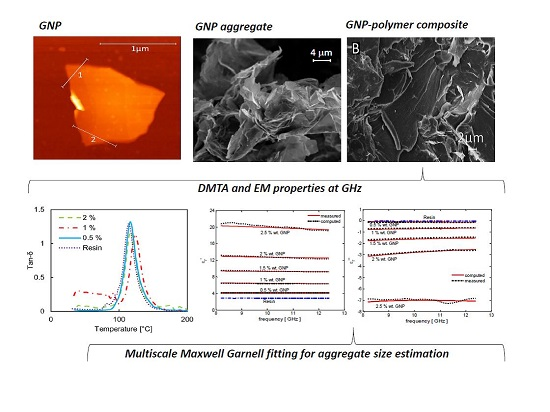Electromagnetic and Dynamic Mechanical Properties of Epoxy and Vinylester-Based Composites Filled with Graphene Nanoplatelets
Abstract
:1. Introduction
2. Materials and Methods
2.1. Materials
2.2. Production Process
2.3. GNP-Composite Characterization
3. Results
3.1. SEM Characterization of Composite Samples
3.2. DMTA
3.3. DC Conductivity Measurement
3.4. Complex Permittivity Measurement
4. Discussion
4.1. Aggregate Average Size Estimation through MMG Modelling
4.2. Effect of Filler Aggregation on the DC Electrical Conductivity of the Composite
5. Conclusions
Acknowledgments
Author Contributions
Conflicts of Interest
Abbreviations
| AFM | Atomic Force Microscopy |
| CNT | Carbon nanotube |
| DMTA | Dynamic Mechanical Thermal Analysis |
| EM | Electromagnetic |
| FE-SEM | Field Emission Scanning Electron Microscopy |
| GHz | Giga-hertz |
| GNP | Graphene Nanoplatelet |
| GO | Graphene oxide |
| HIRF | High intensity radiated field |
| MLG | Multilayer graphene |
| MMG | Multiscale Maxwell Garnett |
| RAM | Radar absorbing material |
| RGO | Reduced GO |
| 2D | Two-dimensional |
References and Notes
- Al-Saleh, M.H.; Saadeh, W.H.; Sundararaj, U. EMI shielding effectiveness of carbon based nanostructures polymeric materials: A comparative study. Carbon 2013, 60, 146–156. [Google Scholar] [CrossRef]
- Gojny, F.H.; Wichmann, M.G.H.; Fiedler, B.; Schulte, K. Influence of different carbon nanotubes on the mechanical properties of epoxy matrix composites—A comparative study. Comp. Sci. Technol. 2005, 65, 2300–2313. [Google Scholar] [CrossRef]
- Fidelus, J.D.; Wiesel, E.; Gojny, F.H.; Schulte, K.; Wagne, H.D. Thermo-mechanical properties of randomly oriented carbon/epoxy nanocomposites. Compos. Part A 2005, 36, 1555–1561. [Google Scholar] [CrossRef]
- Rafiee, M.A.; Rafiee, J.; Wang, Z.; Song, H.; Yu, Z.; Koratkar, N. Enhanced mechanical properties of nanocomposites at low graphene content. ACS Nano 2009, 3, 3884–3890. [Google Scholar] [CrossRef] [PubMed]
- Park, S.; Ruoff, R.S. Chemical methods for the production of graphenes. Nat. Nanotechnol. 2009, 4, 217–224. [Google Scholar] [CrossRef] [PubMed]
- Dreyer, D.R.; Park, S.; Bielawski, C.W.; Ruoff, R.S. The chemistry of graphene oxide. Chem. Soc. Rev. 2010, 39, 228–240. [Google Scholar] [CrossRef] [PubMed]
- Adohi, J.P.; Mdarhri, A.; Prunier, C.; Haidar, B.; Brosseau, C. A comparison between physical properties of carbon black-polymer and carbon nanotubes-polymer composites. J. Appl. Phys. 2010, 108, 074108. [Google Scholar] [CrossRef]
- Qing, Y.; Zhou, W.; Luo, F.; Zhu, D. Microwave-absorbing and mechanical properties of carbonyl-iron/epoxy silicon resin coatings. J. Magn. Magn. Mater. 2009, 321, 25–28. [Google Scholar] [CrossRef]
- Srikanth, V.V.S.S.; Raju, K.C.J. Graphene/Polymer Nanocomposites as Microwave Absorbers. In Springer Series on Polymer and Composite Materials; Springer International Publishing: New York City, NY, USA, 2015; pp. 307–343. [Google Scholar]
- Liu, Z.; Bai, G.; Huang, Y.; Ma, Y.; Du, F.; Li, F.; Guo, T.; Chen, Y. Reflection and absorption contributions to the electromagnetic interference shielding of single-walled carbon nanotube/polyurethane composites. Carbon 2007, 45, 821–827. [Google Scholar] [CrossRef]
- Zhang, J.; Xiao, P.; Zhou, W.; Hong, W.; Luo, H. Preparation and microwave absorbing properties of carbon fibers/epoxy composites with grid structure. Mater. Electron. 2015, 26, 651–658. [Google Scholar] [CrossRef]
- Brosseau, C.; Quéffélec, P.; Talbot, P. Microwave characterization of filled polymers. J. Appl. Phys. 2001, 89, 4532. [Google Scholar] [CrossRef]
- De Bellis, G.; Tamburrano, A.; Dinescu, A.; Santarelli, M.L.; Sarto, M.S. Electromagnetic properties of composites containing graphite nanoplatelets at radio frequency. Carbon 2011, 49, 4291–4300. [Google Scholar] [CrossRef]
- De Rosa, I.M.; Dinescu, A.; Sarasini, F.; Sarto, M.S.; Tamburrano, A. Effect of short carbon fibers and CNTs on microwave absorbing properties of polyester composites containing nickel-coated carbon fibers. Comp. Sci. Technol. 2010, 70, 102–109. [Google Scholar] [CrossRef]
- Qin, F.; Brosseau, C. A review and analysis of microwave absorption in polymer composites filled with carbonaceous particles. J. Appl. Phys. 2012, 111, 061301. [Google Scholar] [CrossRef]
- Du, J.; Cheng, H. The Fabrication, properties, and uses of graphene/polymer composites. Macromol. Chem. Phys. 2012, 213, 1060–1077. [Google Scholar] [CrossRef]
- Adohi, J.P.; Bychanok, D.; Haidar, B.; Brosseau, C. Microwave and mechanical properties of quartz/graphene-based polymer nanocomposites. Appl. Phys. Lett. 2013, 102, 072903. [Google Scholar] [CrossRef]
- Fan, Z.; Luo, G.; Zhang, Z.; Zhou, L.; Wei, F. Electromagnetic and microwave absorbing properties of multi-walled carbon nanotubes/polymer composites. Mater. Sci. Eng B 2006, 132, 85–89. [Google Scholar] [CrossRef]
- Che, B.D.; Nguyen, B.Q.; Nguyen, L.-T.T.; Nguyen, H.T.; Nguyen, V.Q.; Van Le, T.; Nguyen, N.H. The impact of different multi-walled carbon nanotubes on the X-band microwave absorption of their epoxy nanocomposites. Chem. Cent. J. 2015, 9, 10. [Google Scholar] [CrossRef] [PubMed]
- Stankovich, S.; Dikin, D.A.; Piner, R.D.; Kohlhaas, K.A.; Kleinhammes, A.; Jia, Y.; Wu, Y.; Nguyen, S.T.; Ruoff, R.S. Synthesis of graphene-based nanosheets via chemical reduction of exfoliated graphite oxide. Carbon 2007, 45, 1558–1565. [Google Scholar] [CrossRef]
- Paliotta, L.; De Bellis, G.; Tamburrano, A.; Marra, F.; Rinaldi, A.; Balijepalli, S.K.; Kaciulis, S.; Sarto, M.S. Highly conductive multilayer-graphene paper as a flexible lightweight electromagnetic shield. Carbon 2015, 89, 260–271. [Google Scholar] [CrossRef]
- Šupová, M.; Martynková, G.S.; Barabaszová, K. Effect of nanofillers dispersion in polymer matrices: A review. Sci. Adv. Mater. 2011, 3, 1–25. [Google Scholar] [CrossRef]
- Yang, S.; Lin, W.; Huang, Y.; Tien, H.; Wang, J.; Ma, C.M.; Li, S.; Wang, Y. Synergetic effects of graphene platelets and carbon nanotubes on the mechanical and thermal properties of epoxy composites. Carbon 2011, 49, 793–803. [Google Scholar] [CrossRef]
- Tait, M.; Pegoretti, A.; Dorigato, A.; Kalaitzidou, K. The effect of filler type and content and the manufacturing process on the performance of multifunctional carbon/poly-lactide composites. Carbon 2011, 49, 4280–4290. [Google Scholar] [CrossRef]
- Jana, S.C.; Sachin, J. Dispersion of nanofillers in high performance polymers using reactive solvents as processing aids. Polymer 2001, 42, 6897–6905. [Google Scholar] [CrossRef]
- Sarto, M.S.; D’Aloia, A.G.; Tamburrano, A.; De Bellis, G. Synthesis, modeling, and experimental characterization of graphite nanoplatelet-based composites for EMC applications. IEEE Trans. EMC 2012, 54, 17–27. [Google Scholar] [CrossRef]
- D’Aloia, A.G.; Marra, F.; Tamburrano, A.; De Bellis, G.; Sarto, M.S. Electromagnetic absorbing properties of graphene–polymer composite shields. Carbon 2014, 73, 175–184. [Google Scholar] [CrossRef]
- D’Aloia, A.G.; Marra, F.; Tamburrano, A.; De Bellis, G.; Sarto, M.S. Synthesis and characterization of graphene-based nanocomposites for EM shielding applications. In Proceedings of the 2013 International Symposium on Electromagnetic Compatibility (EMC EUROPE), Brugge, Belgium, 2–6 September 2013; IEEE: Brugge, Belgium, 2013; pp. 587–592. [Google Scholar]
- Wang, F.; Qin, Y.; Drzal, L.T.; Huang, Z. Mechanical properties and thermal conductivity of graphene nanoplatelet/epoxy composites. Mater. Sci. 2015, 50, 1082–1093. [Google Scholar] [CrossRef]
- Plyushch, A.; Macutkevic, J.; Kuzhir, P.; Banys, J.; Bychanok, D.; Lambin, P.; Bellucci, S. Electromagnetic properties of graphene nanoplatelets/epoxy composites. Comp. Sci. Technol. 2016, 128, 75–83. [Google Scholar] [CrossRef]
- Ferrari, A.C. Raman spectroscopy of graphene and graphite: Disorder, electron- phonon coupling, doping and non-adiabatic effects. Solid State Commun. 2007, 143, 47–57. [Google Scholar] [CrossRef]
- American Society for Testing Materials. ASTM D5568–14, Standard test method for measuring relative complex permittivity and relative magnetic permeability of solid materials at microwave frequencies. 2014
- Kirkpatrick, S. Percolation and conduction. Rev. Mod. Phys. 1973, 45, 57. [Google Scholar] [CrossRef]
- Stauffer, D.; Ammon, A. Introduction to Percolation Theory; CRC Press: Boca Raton, FL, USA, 1994. [Google Scholar]
- Silva, L.C.O.; Silva, G.C.; Ajayan, P.M.; Soares, B.G. Long-term behavior of epoxy/graphene-based composites determined by dynamic mechanical analysis. Mater. Sci. 2015, 50, 6407–6419. [Google Scholar] [CrossRef]
- Thostensona, E.T.; Ziaeeb, S.; Chou, T. Processing and electrical properties of carbon nanotube/vinyl ester nanocomposites. Comp. Sci. Technol. 2009, 69, 801–804. [Google Scholar] [CrossRef]
- Sihvola, A. Electromagnetic Mixing Formulas and Applications. In IEE Electromagnetic Waves Series; The IEE: London, UK, 1999; p. 47. [Google Scholar]
- Neelakanta, P.S. Handbook of Electromagnetic Modelling; CRC Press: Boca Raton, FL, USA, 1995. [Google Scholar]
- Lagarkov, A.N.; Matytsin, S.M.; Rozanov, K.N.; Sarychev, A.K. Dielectric properties of fiber-filled composites. J. Appl. Phys. 1998, 84, 3806–3814. [Google Scholar] [CrossRef]
- De Rosa, I.M.; Mancinelli, R.; Sarasini, F.; Sarto, M.S.; Tamburrano, A. Electromagnetic design and realization of innovative fiber-reinforced broad-band absorbing screens. IEEE Trans. Electromagn. Compat. 2009, 51, 700–707. [Google Scholar] [CrossRef]
- Koledintseva, M.Y.; Drewniak, J.L.; DuBroff, R.E.; Rozanov, K.N.; Archambeault, B. Modeling of shielding composite materials and structures for microwave frequencies. Prog. Electromagn. Res. B 2009, 15, 197–215. [Google Scholar] [CrossRef]
- Brosseau, C.; Beroual, A. Computational electromagnetics and the rational design of new dielectric heterostructures. Prog. Mater. Sci. 2003, 48, 373–456. [Google Scholar] [CrossRef]
- Myroshnychenko, V.; Brosseau, C. Finite-element modeling method for the prediction of the complex effective permittivity of two-phase random statistically isotropic heterostructures. J. Appl. Phys. 2005, 97, 044101. [Google Scholar] [CrossRef]
- Liu, H.L.; Carr, G.L.; Worsley, K.A.; Itkis, M.E.; Haddon, R.C.; Caruso, A.N.; Tung, L.-C.; Wang, Y.J. Exploring the charge dynamics in graphite nanoplatelets by THz and infrared spectroscopy. New J. Phys. 2010, 12, 113012. [Google Scholar] [CrossRef]
- D’Aloia, A.G.; D’Amore, M.; Sarto, M.S. Terahertz shielding effectiveness of graphene-based multilayer screens controlled by electric field bias in a reverberating environment. IEEE Trans. Terahertz Sci. Technol. 2015, 5, 628–636. [Google Scholar] [CrossRef]
- Garboczi, E.J.; Snyder, K.A.; Douglas, J.F.; Thorpe, M.F. Geometrical percolation threshold of overlapping ellipsoids. Phys. Rev. E 1995, 52, 819. [Google Scholar] [CrossRef]
- Lu, C.; Mai, Y.W. Influence of aspect ratio on barrier properties of polymer-clay nanocomposites. Phys. Rev. Lett. 2005, 95, 088303. [Google Scholar] [CrossRef] [PubMed]
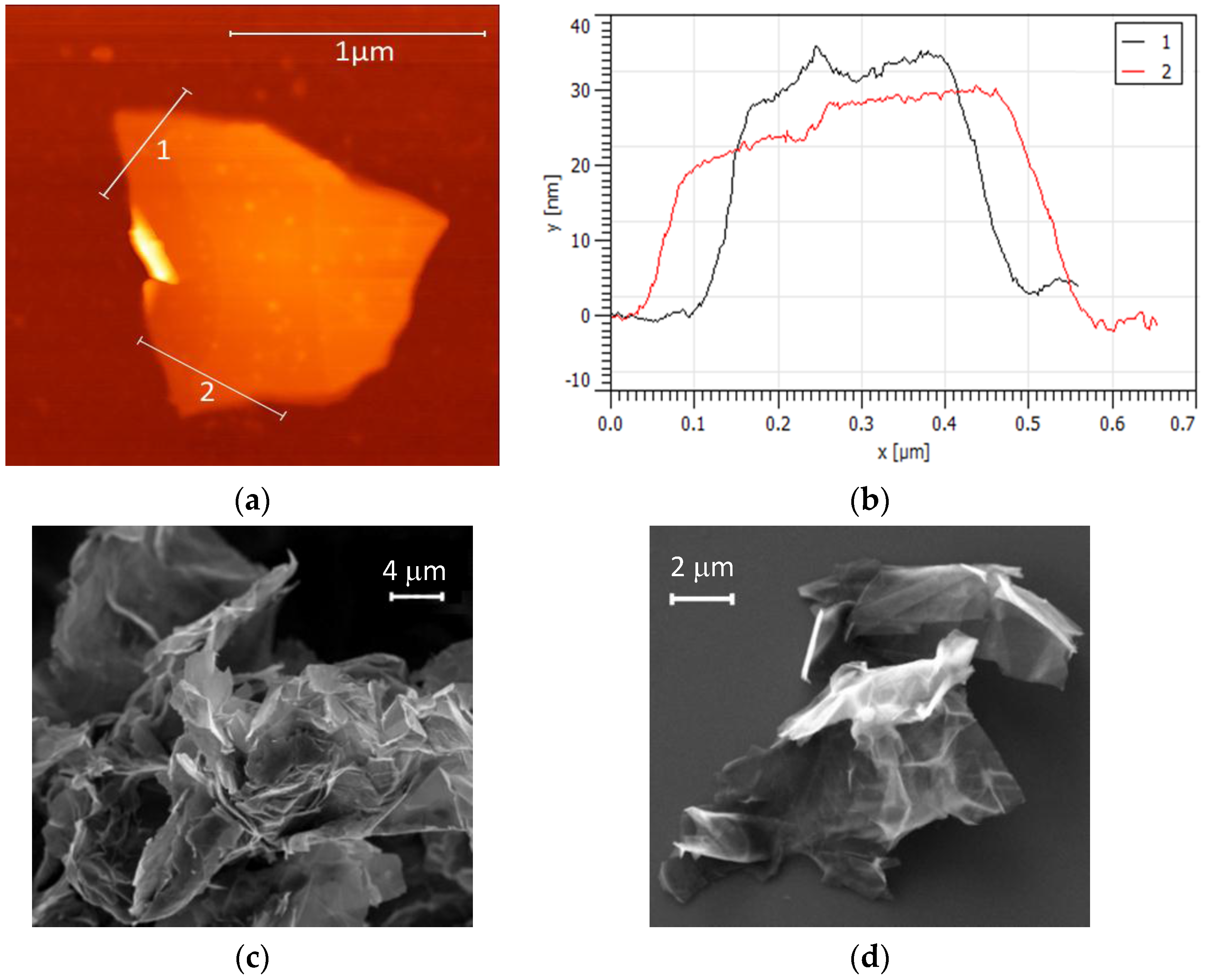
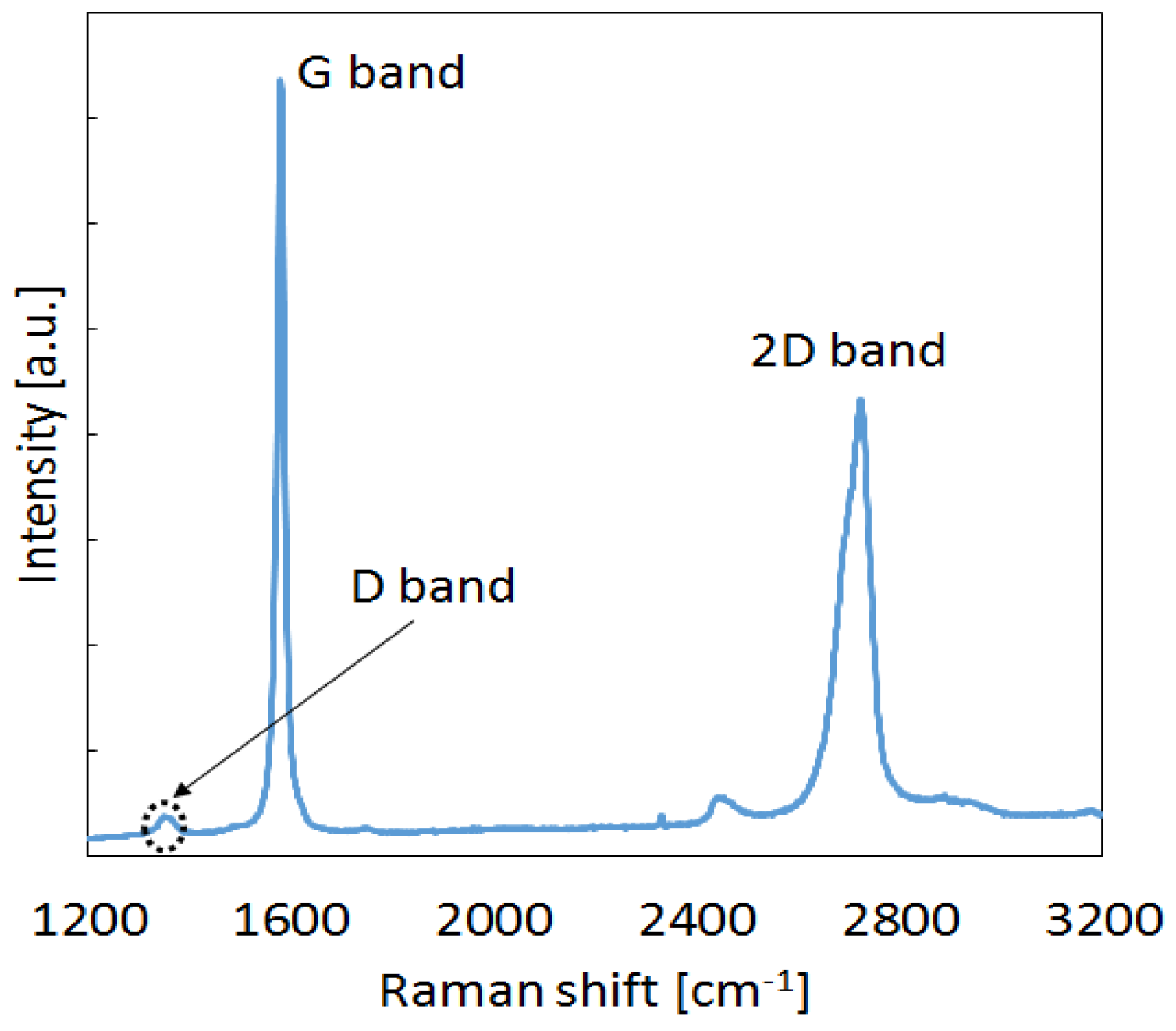
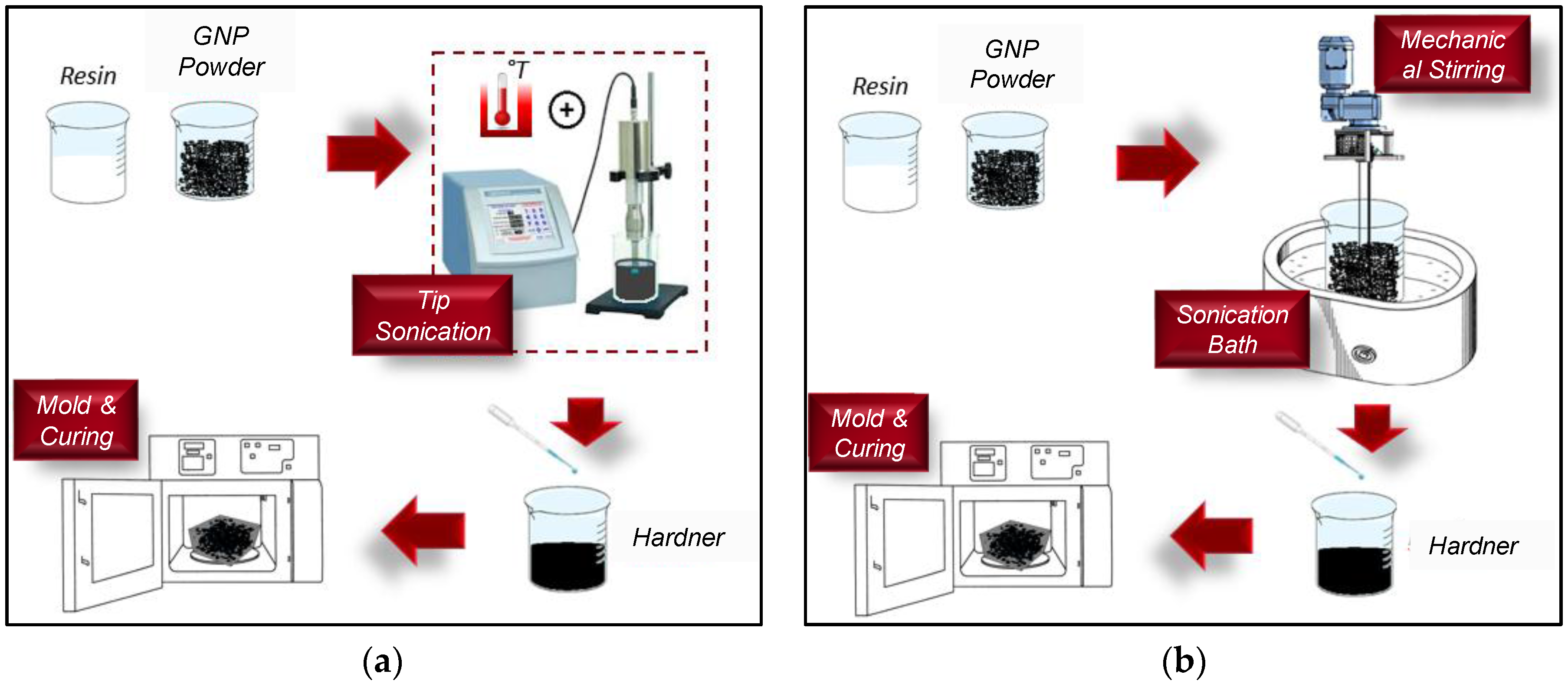
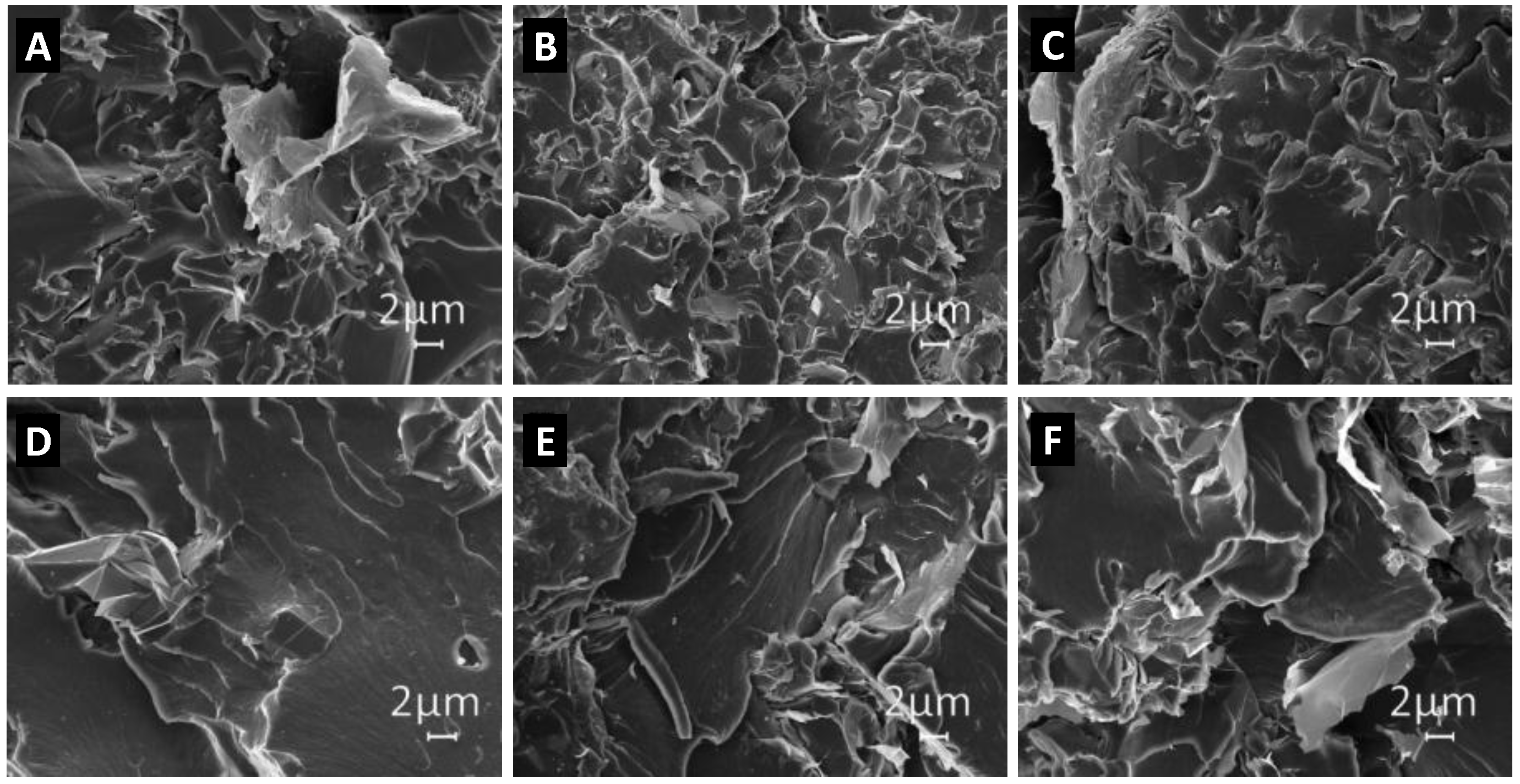
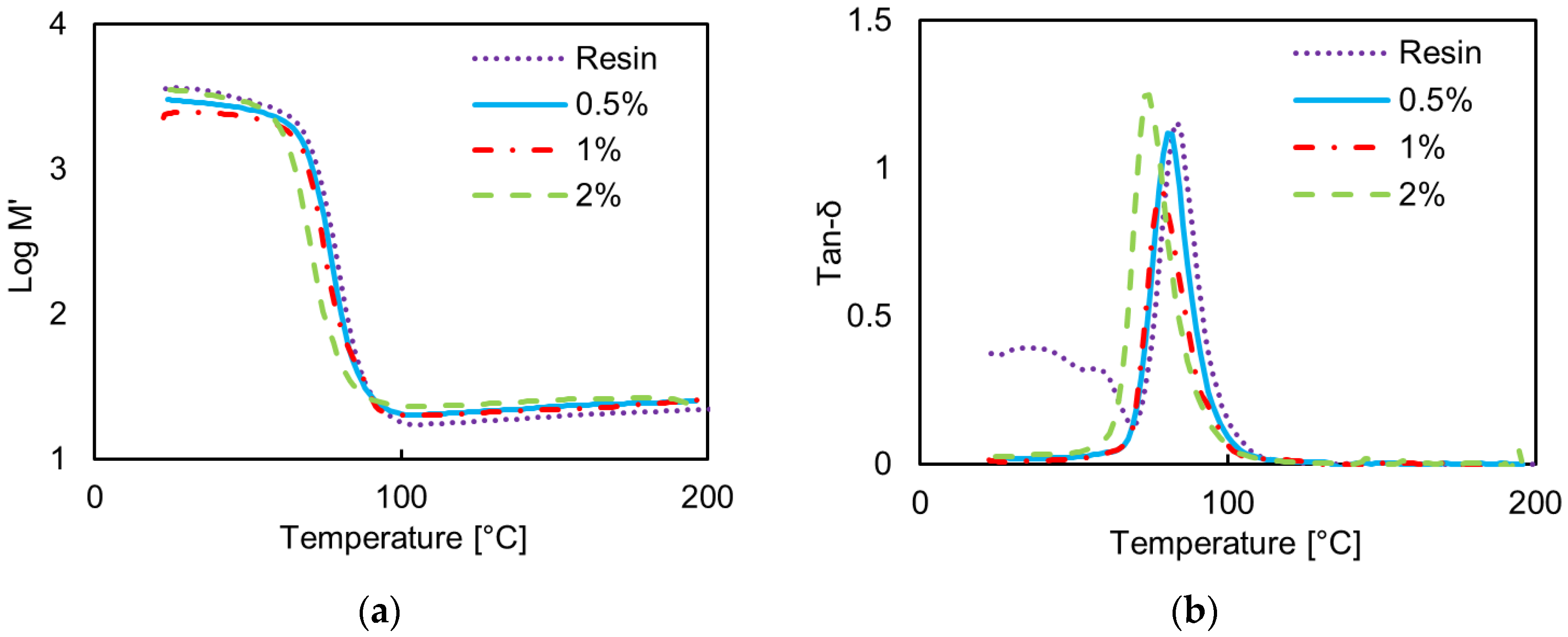
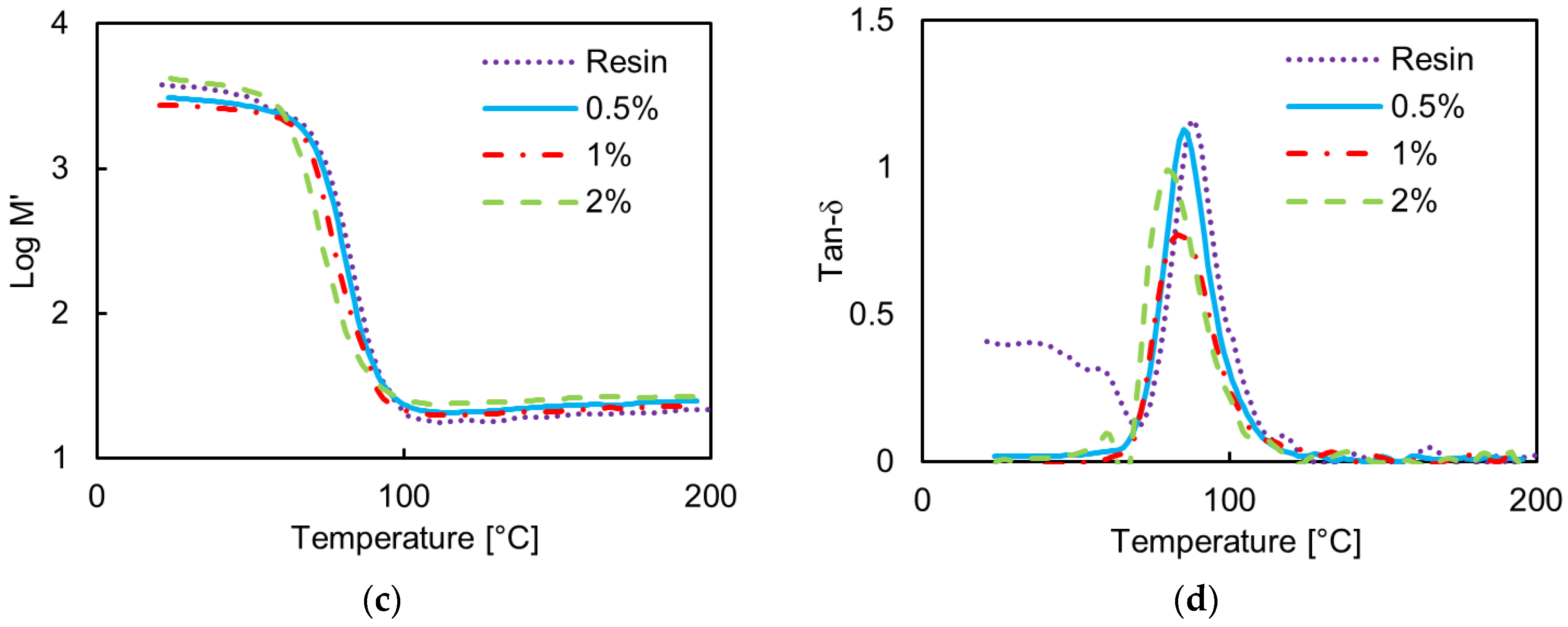
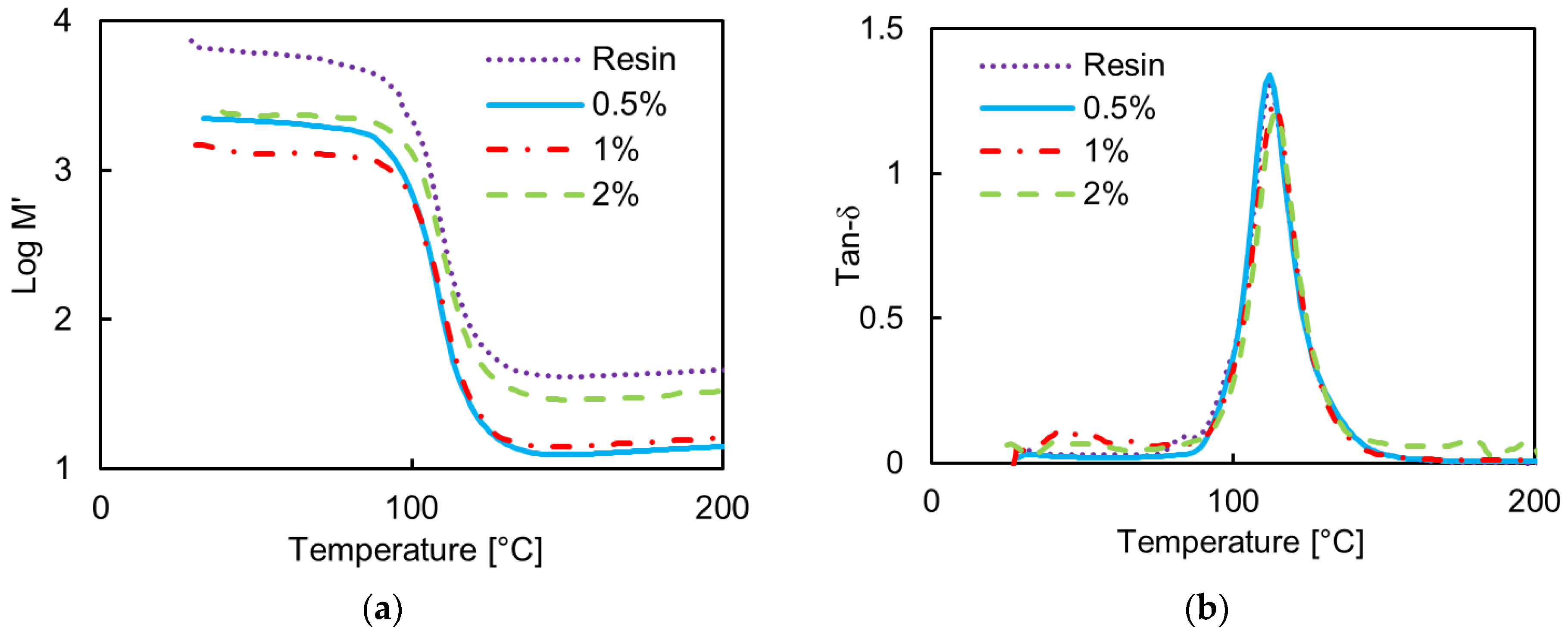
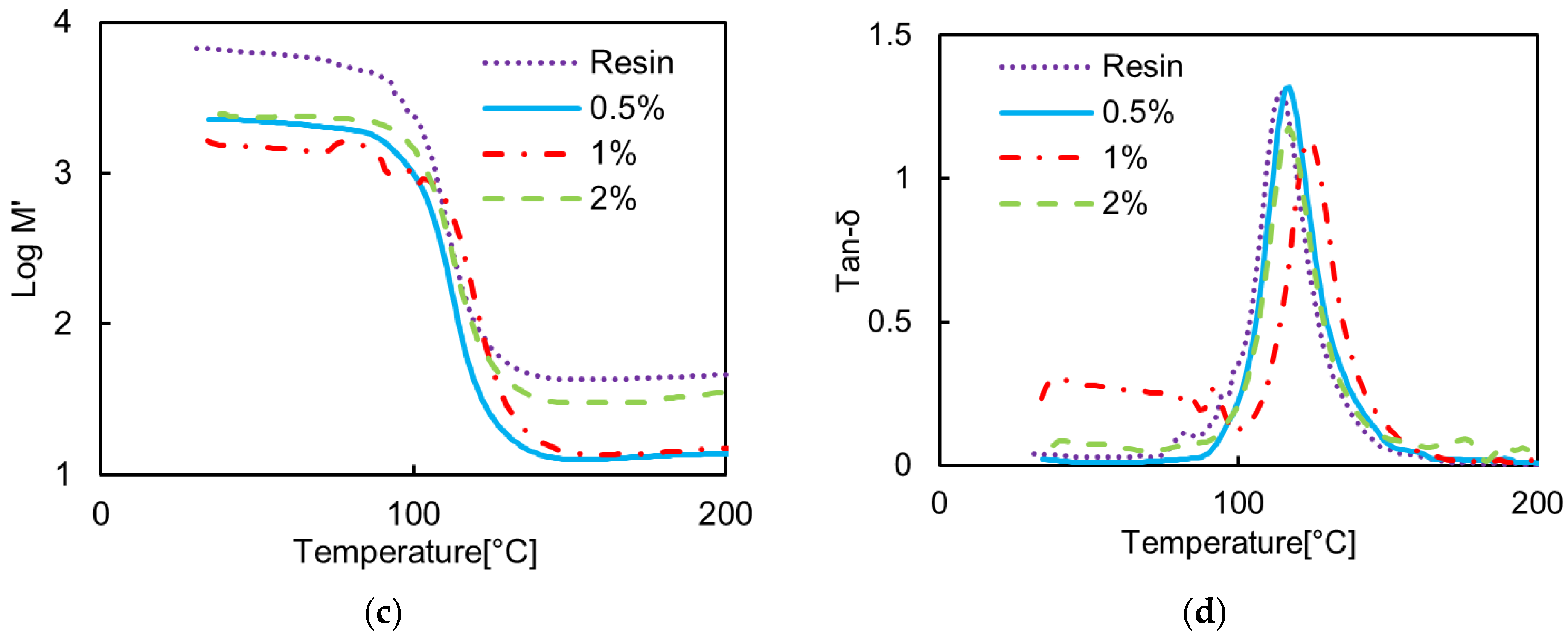
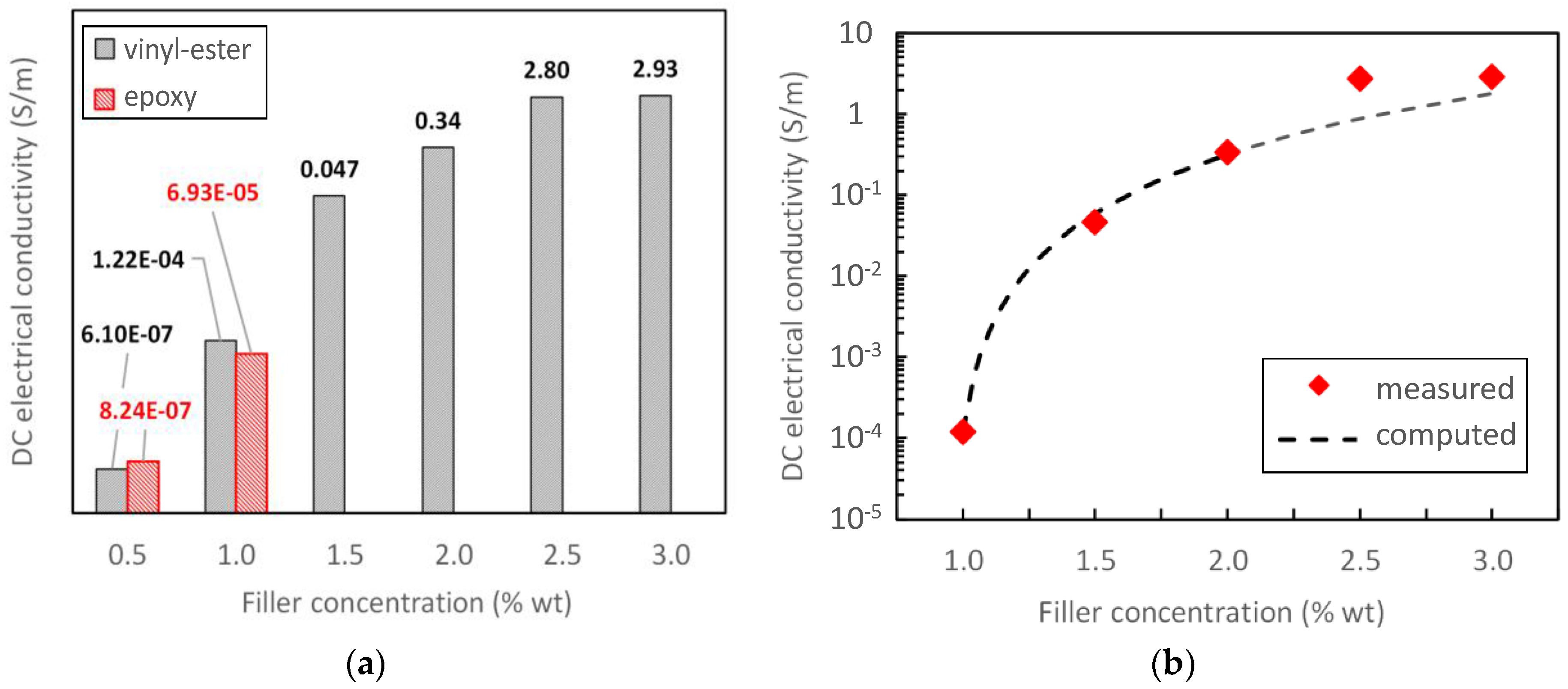
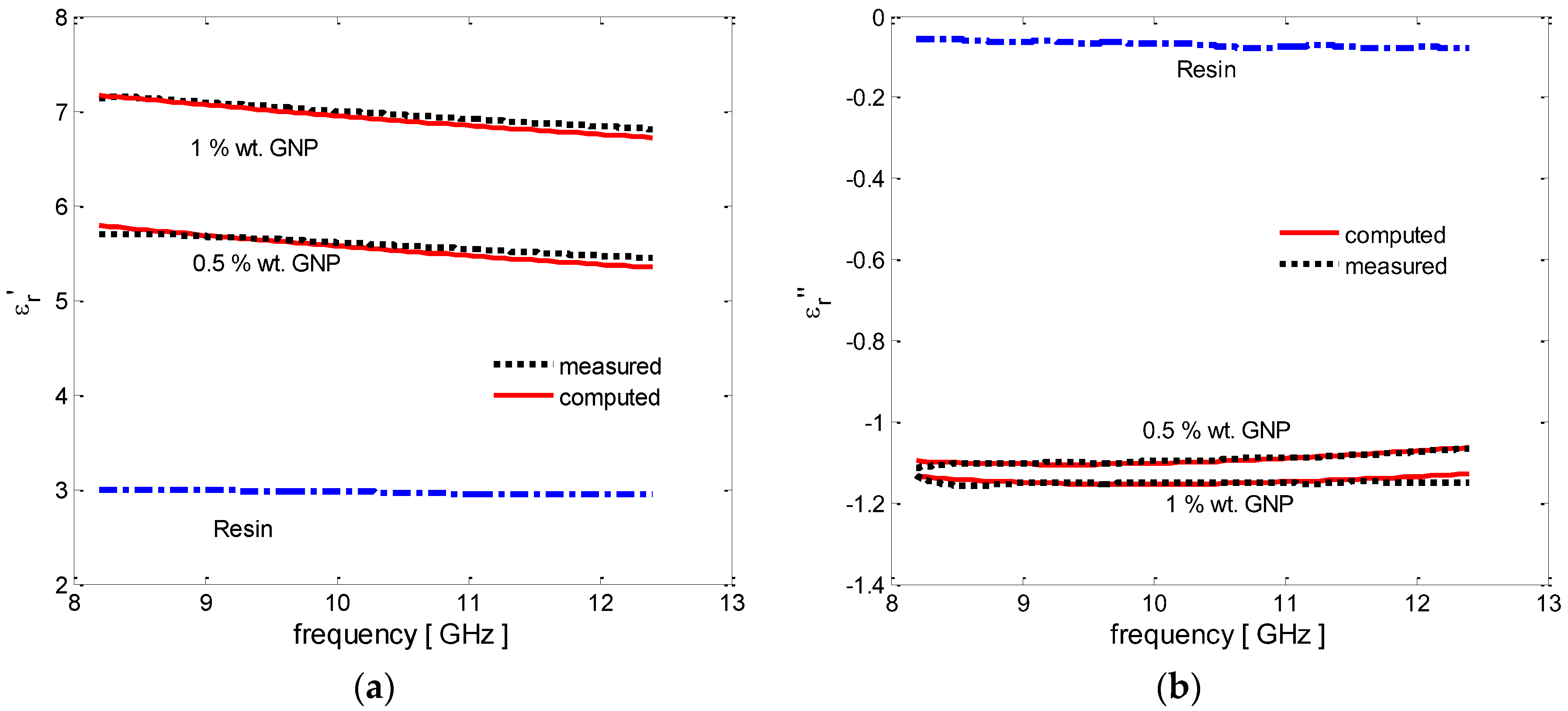
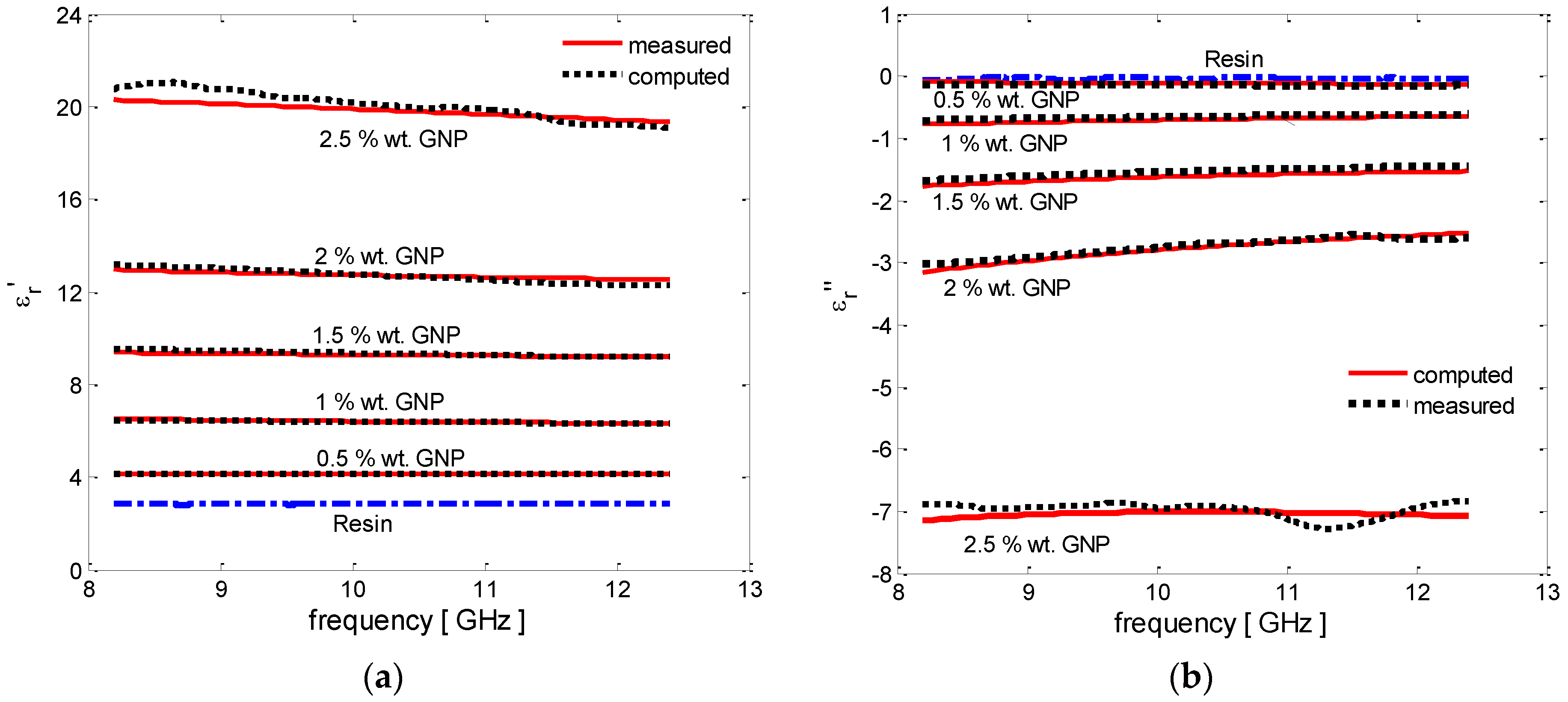
| (wt %) | (kS/m) | = (μm) | (nm) | (wt %) | (kS/m) | (nm) |
|---|---|---|---|---|---|---|
| 0.5 | 11 | 6.5 | 55 | 0.0925 | 5 | 88 |
| 1 | 11 | 8 | 60 | 0.045 | 5 | 90 |
| (wt %) | (kS/m) | (μm) | (nm) | (wt %) | (kS/m) | (nm) |
|---|---|---|---|---|---|---|
| 0.5 | 11 | 7.2 | 61 | 0.065 | 5 | 134 |
| 1 | 11 | 15 | 70 | 0.045 | 5 | 140 |
| 1.5 | 11 | 28 | 65 | 0.105 | 5 | 143 |
| 2 | 11 | 23 | 70 | 0.14 | 5 | 154 |
| 2.5 | 11 | 29 | 73 | 0.193 | 5 | 164 |
| (wt %) | (wt %) | (wt %) | (wt %) | ||
|---|---|---|---|---|---|
| Garboczi [46] | Lu [47] | Garboczi [46] | Lagarkov [39] | ||
| 0.5 | 1.95 | 3.33 | 0.093 | 1.47 | 2.46 |
| 1 | 1.72 | 2.94 | 0.045 | 1.22 | 2.04 |
| (wt %) | (wt %) | (wt %) | (wt %) | ||
|---|---|---|---|---|---|
| Garboczi [46] | Lu [47] | Garboczi [46] | Lagarkov [39] | ||
| 0.5 | 1.95 | 3.33 | 0.065 | 2.026 | 3.4 |
| 1 | 1.07 | 1.82 | 0.045 | 1.009 | 1.69 |
| 1.5 | 0.53 | 0.9 | 0.11 | 0.55 | 0.92 |
| 2 | 0.7 | 1.18 | 0.14 | 0.72 | 1.21 |
| 2.5 | 0.57 | 0.98 | 0.19 | 0.61 | 1.021 |
© 2016 by the authors. Licensee MDPI, Basel, Switzerland. This article is an open access article distributed under the terms and conditions of the Creative Commons Attribution (CC-BY) license ( http://creativecommons.org/licenses/by/4.0/).
Share and Cite
Marra, F.; D’Aloia, A.G.; Tamburrano, A.; Ochando, I.M.; De Bellis, G.; Ellis, G.; Sarto, M.S. Electromagnetic and Dynamic Mechanical Properties of Epoxy and Vinylester-Based Composites Filled with Graphene Nanoplatelets. Polymers 2016, 8, 272. https://doi.org/10.3390/polym8080272
Marra F, D’Aloia AG, Tamburrano A, Ochando IM, De Bellis G, Ellis G, Sarto MS. Electromagnetic and Dynamic Mechanical Properties of Epoxy and Vinylester-Based Composites Filled with Graphene Nanoplatelets. Polymers. 2016; 8(8):272. https://doi.org/10.3390/polym8080272
Chicago/Turabian StyleMarra, Fabrizio, Alessandro Giuseppe D’Aloia, Alessio Tamburrano, Isabel Maria Ochando, Giovanni De Bellis, Gary Ellis, and Maria Sabrina Sarto. 2016. "Electromagnetic and Dynamic Mechanical Properties of Epoxy and Vinylester-Based Composites Filled with Graphene Nanoplatelets" Polymers 8, no. 8: 272. https://doi.org/10.3390/polym8080272






